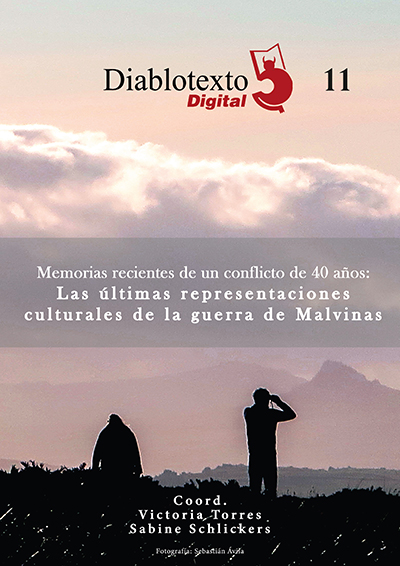The shape of the story about Malvinas: literature and film
DOI:
https://doi.org/10.7203/diablotexto.11.24650Keywords:
War, literature, fiction, Malvinas Islands, social memory, Dictatorship Abstract
Abstract
This article examines two novels, Trasfondo y Para un soldado desconocido, which refer to the Malvinas War and challenge the reader's preconceived ideas. The fictions that literature proposes seek to make visible the framework by which power and war determine the lives of men and respond to that secret appointment that, according to Walter Benjamin, the present has with the generations of the past. We add a coda: the documentary Las aspirantes by Gretel Suárez that reveals a secret account of the nursing students who participated in the Malvinas War.
 Downloads
Downloads
 References
References
Alberdi, Juan Bautista (2007). El crimen de la guerra. San Martín: UNSAM.
Barthes, Roland (1996). Fragmentos de un discurso amoroso. Buenos Aires: Siglo XXI.
Benjamin, Walter (1973). “Tesis sobre filosofía de la historia”. En Iluminaciones I. Madrid: Taurus, pp. 175-194.
Didi-Huberman, Georges (2006). "L'image brûle". En Zimmermann, L., Didi-Huberman, G., et al, Penser par les images. Nantes: Editions Cécile Defaut, pp. 11-52.
Foucault, Michel (1988). Nietzsche, La Genealogía, La Historia. Valencia: Pre-Textos.
Foucault, Michel (1992). Genealogía del racismo. Madrid: Ed. La Piqueta.
Haraway, Donna (2004). The Haraway Reader, traducción de Pau Pitarch. New York: Routledge, pp. 223- 250.
Kohan, Martín (2014). El país de la guerra. Buenos Aires: Eterna Cadencia.
Leibniz, Gotfried (1984). Monadología. Madrid: Ediciones Orbis.
Lorenz, Federico (2022a). “Las cosas que llevaban”, DiarioAR, 30 de marzo de 2022. Disponible en https://www.eldiarioar.com/politica/40-anos-de-malvinas/cosas-llevaban_129_8873053.html [Fecha de consulta: 28 de mayo 22].
Lorenz, Federico (2022b). Para un soldado desconocido. Buenos Aires: Adriana Hidalgo.
Nancy, Jean-Luc. (2003). La comunidad inoperante. Santiago de Chile: Libros Arces.
Piglia, Ricardo (1972). “Mao Tse-Tung. Práctica estética y lucha de clases”, Los Libros, n.º 25, pp. 22-25.
Piglia, Ricardo y Rozitchner, León (2001). Tres propuestas para el próximo milenio (y cinco dificultades). Mi Buenos Aires querida. Buenos Aires: Fondo de Cultura Económica.
Rancière, Jacques (2005). “El viraje ético de la estética y la política”, Revista Fractal, n.º 37. Disponible en <https://www.mxfractal.org/JacquesRanciere.html> [Fecha de consulta: 31 de mayo de 2022].
Ratto, Patricia (2008). Nudos. Buenos Aires: Adriana Hidalgo.
Ratto, Patricia (2012). Trasfondo. Buenos Aires: Adriana Hidalgo.
Ratto, Patricia (2917) Fauna. Buenos Aires: Adriana Hidalgo.
Rojas, Ricardo (1922). La argentinidad. Ensayo histórico sobre nuestra conciencia nacional en la gesta de la emancipación, 1810-1816. Buenos Aires: Librería La Facultad. Juan Roldán y Cfa.
Saer, Juan José (2014). El concepto de ficción. Buenos Aires: Seix Barral.
Schaeffer, Jean-Marie (2009). El fin de la excepcionalidad humana. Buenos Aires: Fondo de Cultura Económica.
Suárez, Gretel (2017). Las aspirantes. Disponible en https://www.youtube.com/watch?v=F9FFtyGwbH8&t=5shttps://www.youtube.com/watch?v=F9FFtyGwbH8&t=5s [Fecha de consulta: 28 de mayo de 2022]
Wolf, Christa (1986). Casandra. Traducción de Miguel Sáenz. Madrid: Ediciones Alfaguara.
Downloads
Published
How to Cite
-
Abstract328
-
PDF (Español)187
Issue
Section
License
Licencia de reconocimiento de Creative Commons “Reconocimiento - No Comercia l- Sin Obra Derivada
Authors who publish with this journal agree to the following items:
The authors will keep their copyright and guarantee the journal the right of first publication of their work, which will be simultaneously subject to the Creative Commons license that allows third parties to share the work indicating its author and its first publication in the journal. The authors may adopt other non-exclusive license agreements to distribute the version of the published work (e.g., depositing it in an institutional telematic file or publishing it in a monographic volume), with an acknowledgment of its initial publication in this journal. The authors are allowed and encouraged to disseminate their work through the Internet (e.g., in institutional telematic archives or on their website) before and during the submission process, which can produce interesting exchanges and increase citations of the published work. (See Effect of Open Access)




